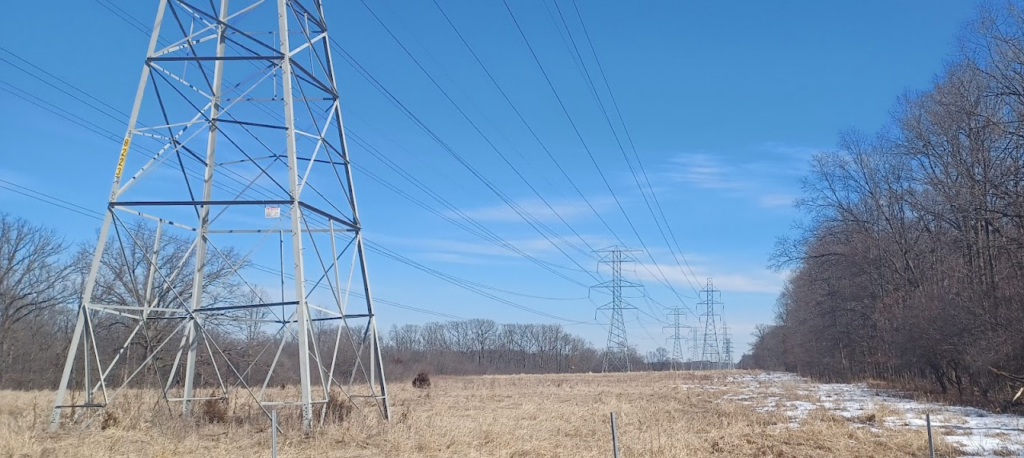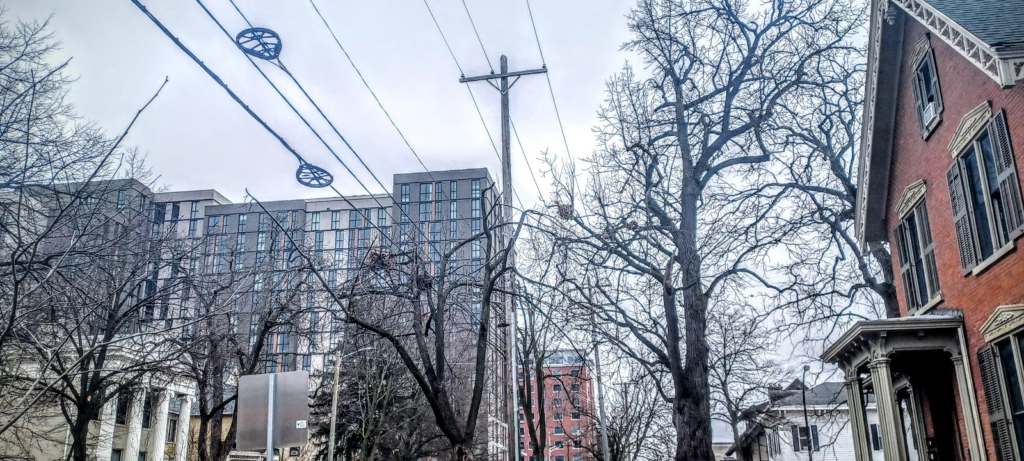In a Nutshell
- The socioeconomic costs of power outages have not traditionally been considered in utility service planning and regulation. The Michigan Public Service Commission is in the initial phases of a long-term effort to transition the power grid for emerging challenges, but has limited regulatory authority.
- Relocating existing power distribution lines to underground is one option to reduce power outages, but is rarely considered due to cost considerations. These considerations assume the utility will bear the full cost. However, the cost can be mitigated if undergrounding is done in collaboration with others.
- Dig-once construction will not advance in Michigan without a coherent state policy to enable it. Michigan should pursue policies that facilitate and compel multi-agency ‘dig-once’ project coordination to underground distribution lines when feasible.
By Eric Paul Dennis, PE – epdennis@crcmich.org
Several bouts of winter weather in February and March of 2023 wreaked havoc on Michigan’s power grid. Hundreds of thousands of electric utility customers experienced outages, some for multiple days. There are many practical, technical, and regulatory options to make the grid more resilient. The Michigan Public Service Commission (MPSC) is in the process of implementing new oversight and regulatory functions that should result in a more reliable grid that is better able to withstand emerging challenges. However, the potential to improve power reliability by undergrounding existing utility distribution lines is being overlooked. Successful undergrounding of existing overhead lines will require policies that incentivize ‘dig-once’ approaches to infrastructure planning.
The 2023 Winter Storms
On February 22, 2023, a late winter storm covered lower Michigan with up to three-quarters of an inch of ice. The weight of the ice brought down tree limbs and power lines across the region. Well over a half million utility customers were left without power, many for multiple days. As utility companies worked to restore power and repair damaged equipment, another ice storm hit southwest Michigan on February 27, knocking power out for tens of thousands more. Only a few days later, on March 3, the region was blanketed with up to 10 inches of especially wet, heavy snow, bringing down more trees and powerlines. Hundreds of thousands more residents were left in the dark.
It is impossible to estimate the total socioeconomic costs of the power outages caused by this devastating string of storms. The expenses borne by the utilities for emergency crews to remove downed trees and repair damaged equipment is only a fraction of the full cost to citizens and businesses across the state. The extended outages severely disrupted the lives of hundreds of thousands of Michiganders and cost at least one life – a 28-year-old volunteer first responder from Paw Paw.
The disruption caused by the winter 2023 power outages has led to widespread anger directed at Michigan’s largest utility companies, DTE and Consumers Energy. While the storms were particularly devastating, the resulting outages reflect a larger pattern. A report by the Citizens Utility Board of Michigan establishes that, “Michigan utilities…have below average performance on most metrics that measure the primary purposes of a utility: the delivery of reliable and affordable energy service to customers.” Many citizens and public officials have called for increased regulation and oversight of the utilities’ business practices and investment decisions.
But Michigan’s investor-owned utility companies are already very heavily regulated by multiple agencies. Every significant decision by power utilities has been permitted, if not incentivized, by regulatory authorities such as the MPSC and Federal Energy Regulatory Commission (FERC).
Regulation of Investor-owned Utility Companies
Regulators have historically required utility companies to justify their investments on the basis of something called “least cost – best fit” (LCBF), wherein power companies make the minimum required investments to deliver service at the least cost to ratepayers. This approach often discourages utilities from making investments that would make the grid resilient to low-frequency storm events, because the costs and benefits are considered from the perspective of the utility companies and the customers as ratepayers.
The utilities’ primary costs are the construction, operation, maintenance, and emergency repair of the equipment. The benefits are the profits derived from selling electricity. This is considered to be in the interest of ratepayers because the intended result is “safe and adequate” electric service delivered at the lowest feasible cost. This is the optimal approach from an accounting perspective; fixing the occasional downed wire is cheaper than upgrading the whole grid. However, this does not include the broader external costs that severe power outages impose on people and the economy.
Michigan residents pay, on average, a higher rate than peer states.
Electricity Rates in Great Lakes States, 2000 to 2020

Source: Status of Electric Competition in Michigan, Michigan Public Service Commission, February 1, 2023.
Storms and Trees: The Scourge of Electric Utilities
Power outages occur for a variety of reasons, but the most common cause is damage from trees. Outages can be prevented by trimming and removing trees from near power lines, as well as by upgrading hardware with modern equipment that is more resilient to wind, ice, and tree impacts. Michigan’s utilities are actively investing both in more frequent vegetation maintenance and grid “hardening” projects that make circuits more weather resilient.
Michigan is a heavily wooded state where trees grow fast and there is year-round potential for destructive storms. Power outages during storm events are practically unavoidable so long as power lines remain above ground. Tree-related damage can be mitigated. But for catastrophic storms that knock down mature trees and large limbs, the only way to prevent subsequent power outages is to remove all trees and vegetation that could possibly impact the lines. This is standard practice for high-voltage transmission lines that carry electricity from power plants to substations, but not the distribution lines that carry power from substations to customers.
Distribution lines are everywhere. Completely removing hazardous trees from near these lines would be devastating to our urban forests and environment. Tree trimming programs are effective at reducing power outages, but do not eliminate the risk of storm damage. Further, tree trimming programs do not consider the value of trees as a critical component of urban infrastructure. Trees are pruned to provide clearance from the electrical lines without regard for aesthetics or health of the tree. As such, tree trimming is often highly unpopular. It is also costly, as it requires crews to work around live wires and must be conducted frequently to manage new growth.
For high-voltage transmission lines, trees are entirely removed to meet reliability standards established by the Federal Energy Regulatory Commission.

For low-voltage distribution lines, trees are trimmed to reduce, but not eliminate, the potential for storm damage. Telecommunications (broadband) lines are also at risk.

Undergrounding Distribution Lines: An Effective but Costly Solution
Storm damage can be almost entirely prevented by routing power lines underground. This is well understood. Many power lines are run underground, especially in new subdivision developments. However, in most of Michigan’s developed urban areas, power lines are run overhead on utility poles. It is rare that existing above-ground power lines are relocated underground because it simply costs too much. The estimated benefits to ratepayers of more reliable service and avoidance of occasional outages do not typically justify the costs (which would be imposed on ratepayers).
A DTE pilot in Detroit concluded that undergrounding an existing back-of-lot overhead line would cost three times as much as updating and hardening the line. Other cost estimates for relocating lines underground can be up to ten times the cost of simply updating overhead lines. Many overhead lines have recently been updated and are not scheduled for replacement for many decades. This means that undergrounding these lines would be a wholly added cost, offset only by the avoided costs of potential storm damage and tree trimming programs.
The MPSC is working with utilities to develop new benefit cost analysis frameworks that better account for the costs and benefits of power outages from a societal perspective, rather than a narrow accounting of direct utility and ratepayer costs. This reform may increase the frequency of undergrounding projects by more appropriately valuing the benefits. Currently, pilot programs from DTE, Consumers Energy, and others are being used to better understand the costs and target locations for relocating existing distribution lines to underground. However, even with these updated approaches, many opportunities to underground powerlines will be overlooked because all project costs are assumed to be borne by the utility and subsequently passed on to ratepayers. From this narrow perspective, the benefits of improved reliability often will not justify the costs to the utility or their customers.
This approach overlooks the fact that the cost of undergrounding power lines can be greatly reduced if coordinated with other work, especially road reconstruction.
Reducing Undergrounding Costs through ‘Dig-Once’ Coordination, Barriers
‘Dig-once’ is the idea that when a road agency or utility company performs construction, other agencies should seek to perform needed work at the same time to avoid the excessive costs and disruptions of multiple construction projects. For example, when a road is reconstructed, the water and sewer lines underneath that road can also be replaced. The potential to reduce infrastructure construction costs through dig-once projects is well understood.
There are multiple platforms in Michigan that are intended to facilitate dig-once coordination, including the Dig Once Project Portal maintained by the Michigan Infrastructure Commission (MIC). The MIC Project Portal aggregates basic project plans (location and date) from multiple agencies in a standard format. Multiple agencies, including DTE and Consumers Energy are actively uploading project plans to the portal, but rarely leverage the data from the platform to coordinate construction projects.
Understanding why dig-once coordination remains rare requires understanding the perspectives and incentives of the individual agencies responsible for the infrastructure assets.
A public road is much more than just a road; it is a ‘right-of-way’ (ROW) used by multiple infrastructure owners and operators. Within that ROW, there may be many infrastructure features, including water mains, gas lines, sanitary and storm sewers, telecommunications lines, and electric power lines. The agencies responsible for these various infrastructure systems all operate independently – they have their own regulators, customers, priorities, and timelines. None of these agencies have dedicated funding or established expertise to pursue multi-agency coordination. Any individual agency that would attempt to spearhead dig-once coordination would assume significant added planning and engineering costs, which may not pay back in successful follow-through, especially if other ROW users cannot be convinced to adjust their own priorities and timelines.
The MIC has encouraged ROW users to leverage the Dig-Once Project Portal, but does not have regulatory authority to compel cooperation. The MPSC has authority to guide the investments of power utilities, but is limited in scope as they only oversee the relationship between the utilities and ratepayers. Public ROW owners, (i.e., municipal governments, counties, and the State of Michigan) have regulatory tools, such as permitting authority, that could compel dig-once coordination, but lack expertise and resources to support such a program.
This is a classic collective action problem. A cooperative effort to implement cross-agency dig-once construction would benefit all utilities and society in general. However, at the project level, it is rarely in the individual interest of every necessary agency to participate. Dig-once construction will not advance in Michigan without a coherent state policy to enable it. The details of such a program will require thorough consideration by policymakers.
Conclusion
Reliable and affordable electric power is essential to today’s society and economy. Michigan has longstanding struggles to maintain electric power service during storm events, often resulting in widespread power outages that last for days. Undergrounding power distribution lines is an effective approach to prevent power outages. Historically, it has been very rare to relocate existing overhead power lines to underground due to project costs. These costs could be substantially reduced through state policy that directs ‘dig-once’ coordination between road agencies, utility companies, and other ROW users. Such policy is a prerequisite for Michigan’s urban infrastructure to become more reliable, resilient, and efficient.
If additional dig-once policy is not established, Michigan’s various public utilities and infrastructure agencies will continue to pursue uncoordinated independent priorities in a wasteful and inefficient manner, with avoidable costs such as frequent power outages imposed upon all Michigan citizens and the economy.
A future CRC web post will provide an overview of existing dig-once efforts and offer advice for Michigan policymakers in designing a statewide policy more likely to encourage cooperative efforts between utilities and other ROW users.
Updated May 15, 2023 to correct a minor typo and correct a hyperlink.
Related CRC Posts
“Dig Once” to Save on Infrastructure Costs
Trees are Critical infrastructure
Creating Stormwater Utilities Would Help Reduce Future Flood Damage

